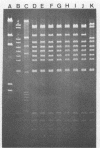Abstract
A total of 1,835 Yersinia spp. were isolated from 925 (60.5%) of 1,530 wild mice and from 139 (79.9%) of 174 moles living in mountainous areas of eastern Shimane Prefecture, Japan. The Yersinia spp. included 1,106 Yersinia enterocolitica, 26 Y. enterocolitica-like, 176 Yersinia mollaretii, 149 Yersinia frederiksenii, 70 Yersinia intermedia, 231 Yersinia kristensenii, 5 Yersinia aldovae, and 72 Yersinia pseudotuberculosis. Human pathogenic Y. enterocolitica was not isolated. Y. pseudotuberculosis was divided into 10 virulent 40- to 50-MDa plasmid-positive (P+) strains (serotypes 1b, 4b, and untypeable) and 62 plasmid-negative (P-) strains (serotypes 1b, 2b, 2c, 4a, 5a, 5b, 6, 7, and untypeable). P+ strains of serotypes 1b (two strains), 4b (seven strains), and untypeable (one strain) were isolated from nine Apodemus specious and one Apodemus argenteus. The isolates of Yersinia spp. were more frequently detected in newborn mice and during the breeding season. The P+ Y. pseudotuberculosis strains were recovered at less than 10(4) cells per g of the cecal contents. Thus, the prevalence of Yersinia spp. in small wild animals depends on the newborn animals born during the cold months, and wild mice in mountainous areas are important reservoirs of Y. pseudotuberculosis.
Full text
PDF







Images in this article
Selected References
These references are in PubMed. This may not be the complete list of references from this article.
- Fukushima H., Gomyoda M., Ishikura S., Nishio T., Moriki S., Endo J., Kaneko S., Tsubokura M. Cat-contaminated environmental substances lead to Yersinia pseudotuberculosis infection in children. J Clin Microbiol. 1989 Dec;27(12):2706–2709. doi: 10.1128/jcm.27.12.2706-2709.1989. [DOI] [PMC free article] [PubMed] [Google Scholar]
- Fukushima H., Gomyoda M., Shiozawa K., Kaneko S., Tsubokura M. Yersinia pseudotuberculosis infection contracted through water contaminated by a wild animal. J Clin Microbiol. 1988 Mar;26(3):584–585. doi: 10.1128/jcm.26.3.584-585.1988. [DOI] [PMC free article] [PubMed] [Google Scholar]
- Fukushima H., Hoshina K., Nakamura R., Ito Y., Gomyoda M. Epidemiological study of Yersinia enterocolitica and Yersinia pseudotuberculosis in Shimane Prefecture, Japan. Contrib Microbiol Immunol. 1987;9:103–110. [PubMed] [Google Scholar]
- Fukushima H., Nakamura R., Iitsuka S., Tsubokura M., Otsuki K., Kawaoka Y. Prospective systematic study of Yersinia spp. in dogs. J Clin Microbiol. 1984 May;19(5):616–622. doi: 10.1128/jcm.19.5.616-622.1984. [DOI] [PMC free article] [PubMed] [Google Scholar]
- Fukushima H., Saito K., Tsubokura M., Otsuki K. Yersinia spp. in surface water in Matsue, Japan. Zentralbl Bakteriol Mikrobiol Hyg B. 1984 Jun;179(3):236–247. [PubMed] [Google Scholar]
- Gemski P., Lazere J. R., Casey T., Wohlhieter J. A. Presence of a virulence-associated plasmid in Yersinia pseudotuberculosis. Infect Immun. 1980 Jun;28(3):1044–1047. doi: 10.1128/iai.28.3.1044-1047.1980. [DOI] [PMC free article] [PubMed] [Google Scholar]
- HIGUCHI K., SMITH J. L. Studies on the nutrition and physiology of Pasteurella pestis. VI. A differential plating medium for the estimation of the mutation rate to avirulence. J Bacteriol. 1961 Apr;81:605–608. doi: 10.1128/jb.81.4.605-608.1961. [DOI] [PMC free article] [PubMed] [Google Scholar]
- Hamasaki S., Hayashidani H., Kaneko K., Ogawa M., Shigeta Y. A survey for Yersinia pseudotuberculosis in migratory birds in coastal Japan. J Wildl Dis. 1989 Jul;25(3):401–403. doi: 10.7589/0090-3558-25.3.401. [DOI] [PubMed] [Google Scholar]
- Hubbert W. T. Yersiniosis in mammals and birds in the United States: case reports and review. Am J Trop Med Hyg. 1972 Jul;21(4):458–463. doi: 10.4269/ajtmh.1972.21.458. [DOI] [PubMed] [Google Scholar]
- Isberg R. R., Falkow S. A single genetic locus encoded by Yersinia pseudotuberculosis permits invasion of cultured animal cells by Escherichia coli K-12. Nature. 1985 Sep 19;317(6034):262–264. doi: 10.1038/317262a0. [DOI] [PubMed] [Google Scholar]
- Kandolo K., Wauters G. Pyrazinamidase activity in Yersinia enterocolitica and related organisms. J Clin Microbiol. 1985 Jun;21(6):980–982. doi: 10.1128/jcm.21.6.980-982.1985. [DOI] [PMC free article] [PubMed] [Google Scholar]
- Kaneko K., Hashimoto N. Occurrence of Yersinia enterocolitica in wild animals. Appl Environ Microbiol. 1981 Mar;41(3):635–638. doi: 10.1128/aem.41.3.635-638.1981. [DOI] [PMC free article] [PubMed] [Google Scholar]
- Kaneko K., Hashimoto N. Prevalence of O agglutinins against the epizootic strains of Yersinia pseudotuberculosis serovars IB and IVA in barn rats. Nihon Juigaku Zasshi. 1982 Apr;44(2):375–377. doi: 10.1292/jvms1939.44.375. [DOI] [PubMed] [Google Scholar]
- Kaneko S., Maruyama T. Relationship between the presence of 44 megadalton plasmid and calcium dependency or autoagglutination to serotype O3 strains of Yersinia enterocolitica. Nihon Juigaku Zasshi. 1986 Apr;48(2):205–210. doi: 10.1292/jvms1939.48.205. [DOI] [PubMed] [Google Scholar]
- Kapperud G. Yersinia enterocolitica in small rodents from Norway, Sweden and Finland. Acta Pathol Microbiol Scand B. 1975 Aug;83(4):335–342. doi: 10.1111/j.1699-0463.1975.tb00110.x. [DOI] [PubMed] [Google Scholar]
- Laird W. J., Cavanaugh D. C. Correlation of autoagglutination and virulence of yersiniae. J Clin Microbiol. 1980 Apr;11(4):430–432. doi: 10.1128/jcm.11.4.430-432.1980. [DOI] [PMC free article] [PubMed] [Google Scholar]
- Mair N. S. Yersiniosis in wildlife and its public health implications. J Wildl Dis. 1973 Jan;9(1):64–71. doi: 10.7589/0090-3558-9.1.64. [DOI] [PubMed] [Google Scholar]
- Simonet M., Richard S., Berche P. Electron microscopic evidence for in vivo extracellular localization of Yersinia pseudotuberculosis harboring the pYV plasmid. Infect Immun. 1990 Mar;58(3):841–845. doi: 10.1128/iai.58.3.841-845.1990. [DOI] [PMC free article] [PubMed] [Google Scholar]
- Toma S. Human and nonhuman infections caused by Yersinia pseudotuberculosis in Canada from 1962 to 1985. J Clin Microbiol. 1986 Sep;24(3):465–466. doi: 10.1128/jcm.24.3.465-466.1986. [DOI] [PMC free article] [PubMed] [Google Scholar]
- Tsubokura M., Inoue M., Nakashima H., Otsuki K., Kawaoka Y. Incidence of Yersinia organism in hare in the northwestern region of Okayama Prefecture. Microbiol Immunol. 1984;28(12):1385–1387. doi: 10.1111/j.1348-0421.1984.tb00796.x. [DOI] [PubMed] [Google Scholar]
- Uchida I., Kaneko K., Hashimoto N. Cross-protection against fecal excretion of Yersinia enterocolitica and Yersinia pseudotuberculosis in mice by oral vaccination of viable cells. Infect Immun. 1982 May;36(2):837–840. doi: 10.1128/iai.36.2.837-840.1982. [DOI] [PMC free article] [PubMed] [Google Scholar]



